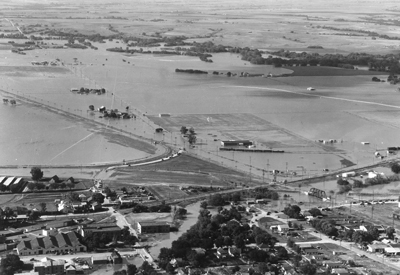Dams Save Oklahoma $33 Million in Flood Damages
“There would have been an additional $33 million in damages from the heavy rainfall the period of May 4-9 if it wasn’t for the flood protection of the state’s 2,105 upstream flood control dams,” said Mike Thralls, Oklahoma Conservation Commission Executive Director. This estimate of damages, provided by the USDA Natural Resources Conservation Service (NRCS), includes damages that would have occurred from flooding such as loss of crops, buildings and livestock, damage to roads and bridges, and damage to land from soil erosion.

Heavy May rains caused some isolated flooding in the state, but when the same amount of rain fell 50 years ago it caused major flooding, not only on thousands of acres of agricultural land, but in many urban areas. The lack of that kind of flooding now, according to Thralls, can be largely attributed to the 2,105 upstream flood control dams that have been constructed in 64 counties over the past 60 years.
“If the remaining 330 planned dams that are awaiting construction had been built they would have reduced damages by another $13 million,” added Thralls. The dams built by local project sponsors, usually conservation districts with the help of the USDA Watershed Program, are designed to capture water from heavy rainstorms and slowly release it over a period of several days, reducing the water flowing in streams and rivers.
Some areas of the state received especially high intensive and heavy rainfall in a short time period. An estimated $585,000 more in damages would have occurred in the Big Wewoka Creek Watershed (Seminole, Hughes and Okfuskee counties) without the flood protection of 41 dams. Over $900,000 damages were prevented by the 35 dams in the Upper Elk Creek Watershed in Beckham, Washita, and Kiowa counties.
“The USDA Watershed Program has provided these kinds of benefits for many years, yet because the dams are relatively small and mostly in rural areas, most people don’t even realize they exist,” according to Thralls. “The program is extremely beneficial to Oklahoma and we are concerned about current efforts to eliminate funding for the program.” Congress provided zero funding for the program in the 2007 fiscal year budget and the President proposed zero funding for the fiscal year 2008 budget.
“If funds are not appropriated for the program, it will not only mean that the 330 planned dams won’t be built, but that the NRCS will no longer be able to provide the much needed engineering assistance to local watershed project sponsors to help maintain the existing dams,” said Thralls. “This could leave conservation districts who have limited funding and staff without the technical help needed to maintain the dams. Many of these dams are 50-60 years old and need continued maintenance or even rehabilitation to keep them safe.”
“We hope that Congress can look at the recent rainstorms not only in Oklahoma, but in many other states and see the multiple benefits of the watershed program and the continuing needs of the program,” said Thralls. “It’s a program that protects not only the economy, but the safety and health of our citizens.”
